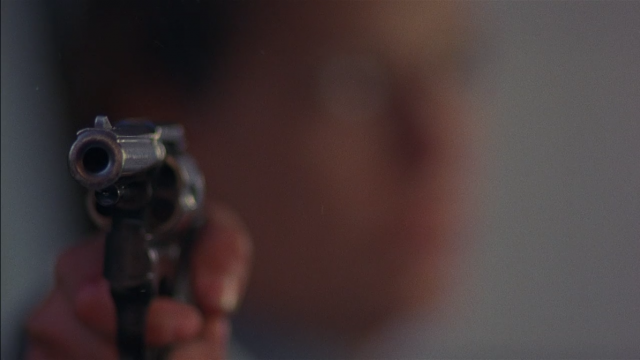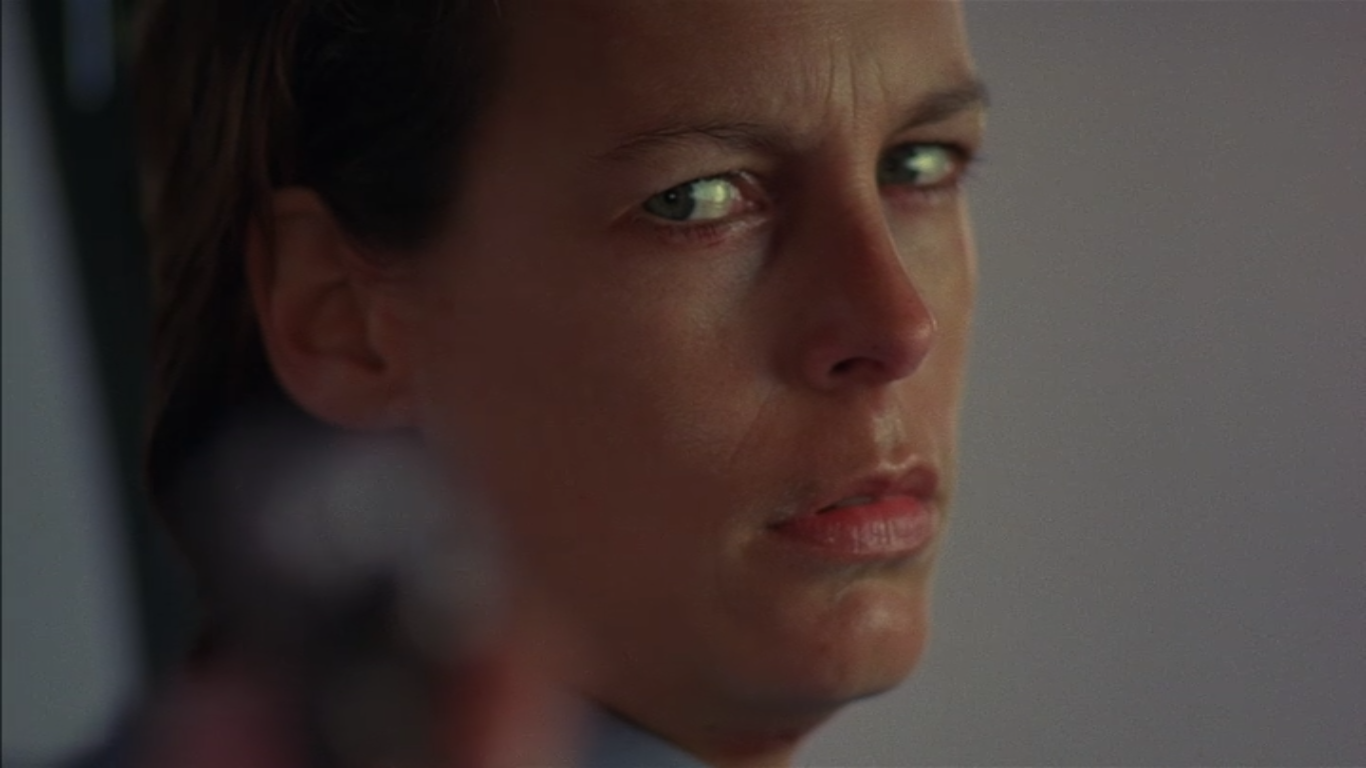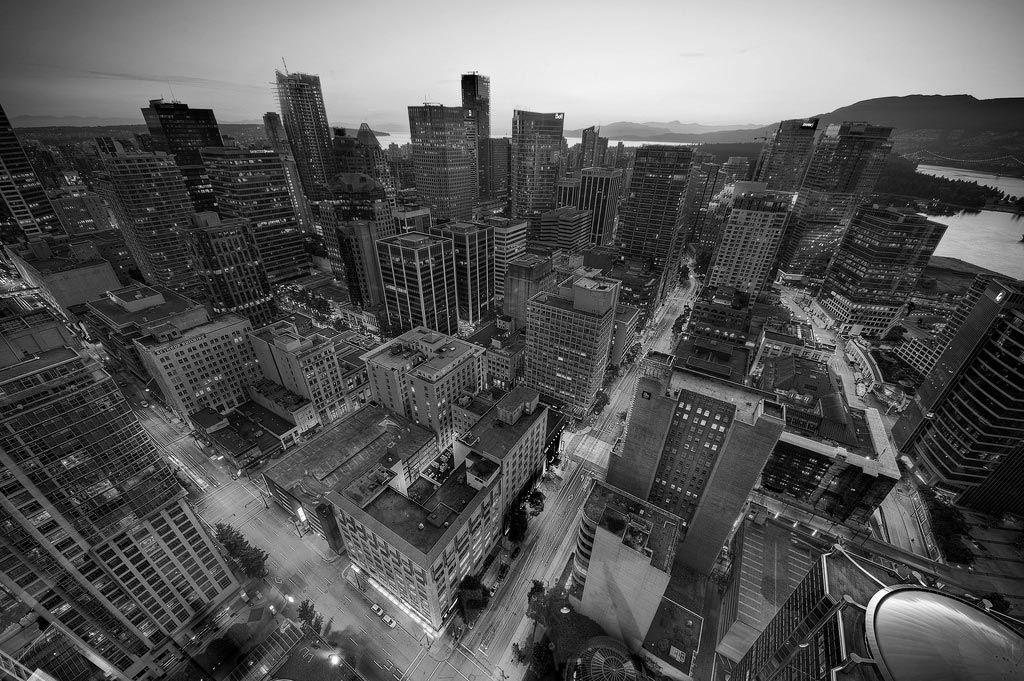Men had it so simple. When it wasn’t about Sticking It In, it was about Having The Gun, a variation that allowed them to Stick It In from a distance. (Thomas Pynchon, Vineland)
Content warning: rape.
The gun is the dick, the dick is the power: from the credit sequence to the last shot, Blue Steel plays variations on this theme in ways that are diverse, disquieting, and almost always compelling. Working again with her Near Dark cowriter, Eric Red, Kathryn Bigelow takes the same horror-movie approach to what is only on the thinnest surface an action movie (subcategory: cop drama) and creates one of her strangest works, a not at all metaphorical struggle between a woman and a man over possession of the Gun. The story comes directly from an earlier film that Red wrote, The Hitcher, where the villain breaks the hero down to the point where the hero kills him, but first by changing the gender of that hero and then through Bigelow’s perpetually fascinated direction, Blue Steel becomes a rich and messy meditation on gun/dick/power, not fully in control of its meanings (or its filmmaking) but all the more interesting for that.
Backed by the electronic zhwooshes of Brad Fiedel’s score, the title comes in as the camera glides along the shaft of a Smith & Wesson .38 in frame-filling closeup, and for the next minute Bigelow’s camera eye continues to caress and explore every aspect of it, down to the cartridges easing snugly into their chambers–which is why, immediately, this movie isn’t just about a gun but the Gun. It’s as openly erotic as the first kiss and bloodsucking was in Near Dark; Bigelow is at her best and most unsettling when she’s most direct, openly showing what others imply. (Nicolas Winding Refn’s statement that he’s a pornographer and shoots what excites him applies just as much to Bigelow, and her influence is all over his work.) Moving out from the Gun, a hand holsters it (holstering and unholstering–concealing and releasing the dick–will be a repeated detail all through the film) and the scene becomes Megan Turner (Jamie Lee Curtis) putting on her uniform as a cop for her Academy graduation, the initiation into the power of the gun that she caps off with photos taken with her best friend (Elizabeth Peña) and the line “I feel like a need a cigarette.”
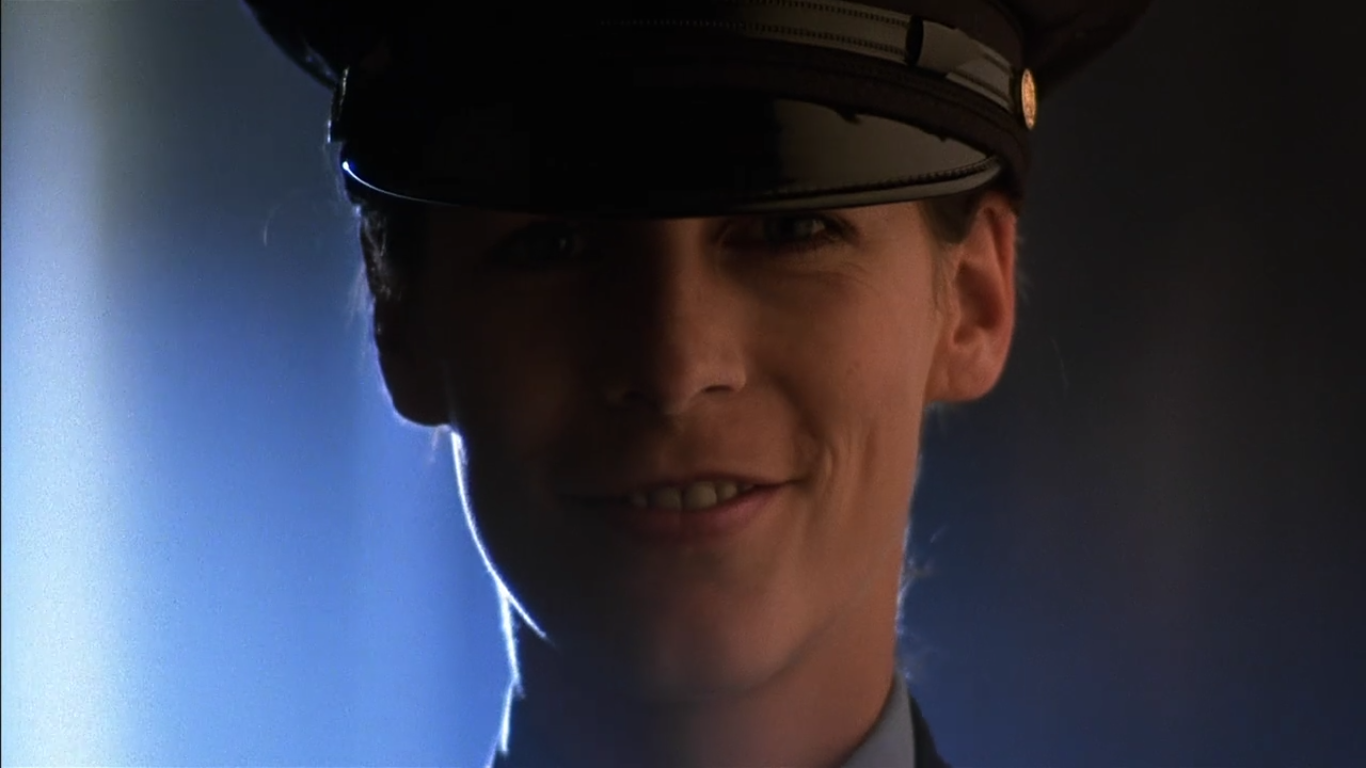 A few minutes later, the plot begins: Turner goes it alone into a grocery store to stop a robbery, and the scene displays what’s great and what’s wrong with Blue Steel. Bigelow’s pacing is excruciatingly good, watching almost every literal step as Turner works her way towards the register where a greasy-as-fuck Tom Sizemore (in the first of three memorable performances for Bigelow) has a gun in the cashier’s face, heightening the sound to catch her breathing, almost catching the sound of her sweat. When Turner opens fire on him, the gunshots are Heat-level loud if not Heat-level accurate and the image is pure violent 80s sensuality as Sizemore bursts blood and flies through the window, and his gun spins in the air (Bigelow tracks that with the same slow motion as Sizemore’s death) and lands in front of Gene Hunt’s (Ron Silver’s) face. He grabs it and takes it away with him. It’s all beautiful, disturbing because of that beauty, but it misses maximum tension because the implausibility takes you out of the experience: Sizemore is robbing one (1) cash register, he’s not opening a vault or anything, so how is this robbery still going on in the time it takes for Turner to run across the street, get to and find the back door (which was apparently unlocked) and then work her way to the front? (Bigelow’s next film, of course, will solve this problem and use the time and scale of its robberies much more effectively.) This is going to be a repeated problem: the story hasn’t been constructed well enough to support its major beats.
A few minutes later, the plot begins: Turner goes it alone into a grocery store to stop a robbery, and the scene displays what’s great and what’s wrong with Blue Steel. Bigelow’s pacing is excruciatingly good, watching almost every literal step as Turner works her way towards the register where a greasy-as-fuck Tom Sizemore (in the first of three memorable performances for Bigelow) has a gun in the cashier’s face, heightening the sound to catch her breathing, almost catching the sound of her sweat. When Turner opens fire on him, the gunshots are Heat-level loud if not Heat-level accurate and the image is pure violent 80s sensuality as Sizemore bursts blood and flies through the window, and his gun spins in the air (Bigelow tracks that with the same slow motion as Sizemore’s death) and lands in front of Gene Hunt’s (Ron Silver’s) face. He grabs it and takes it away with him. It’s all beautiful, disturbing because of that beauty, but it misses maximum tension because the implausibility takes you out of the experience: Sizemore is robbing one (1) cash register, he’s not opening a vault or anything, so how is this robbery still going on in the time it takes for Turner to run across the street, get to and find the back door (which was apparently unlocked) and then work her way to the front? (Bigelow’s next film, of course, will solve this problem and use the time and scale of its robberies much more effectively.) This is going to be a repeated problem: the story hasn’t been constructed well enough to support its major beats.
The next moment works just fine, though–Hunt takes the gun to his apartment; his clothes and bearing already mark him as New York Upper Class (Business Division), so it’s no surprise that he lives in an expensive building, complete with doorman, elevator, and beautiful interior. In a wordless moment, he takes out the shiny new dick that’s suddenly been gifted to him and just looks at it; his body language and gaze suggest fascination but not surprise, like he found something that always belonged to him. Bigelow’s gaze matches his, and so does our fascination, prefiguring the rest of the story: Hunt’s addiction to the power and his inability to control it.
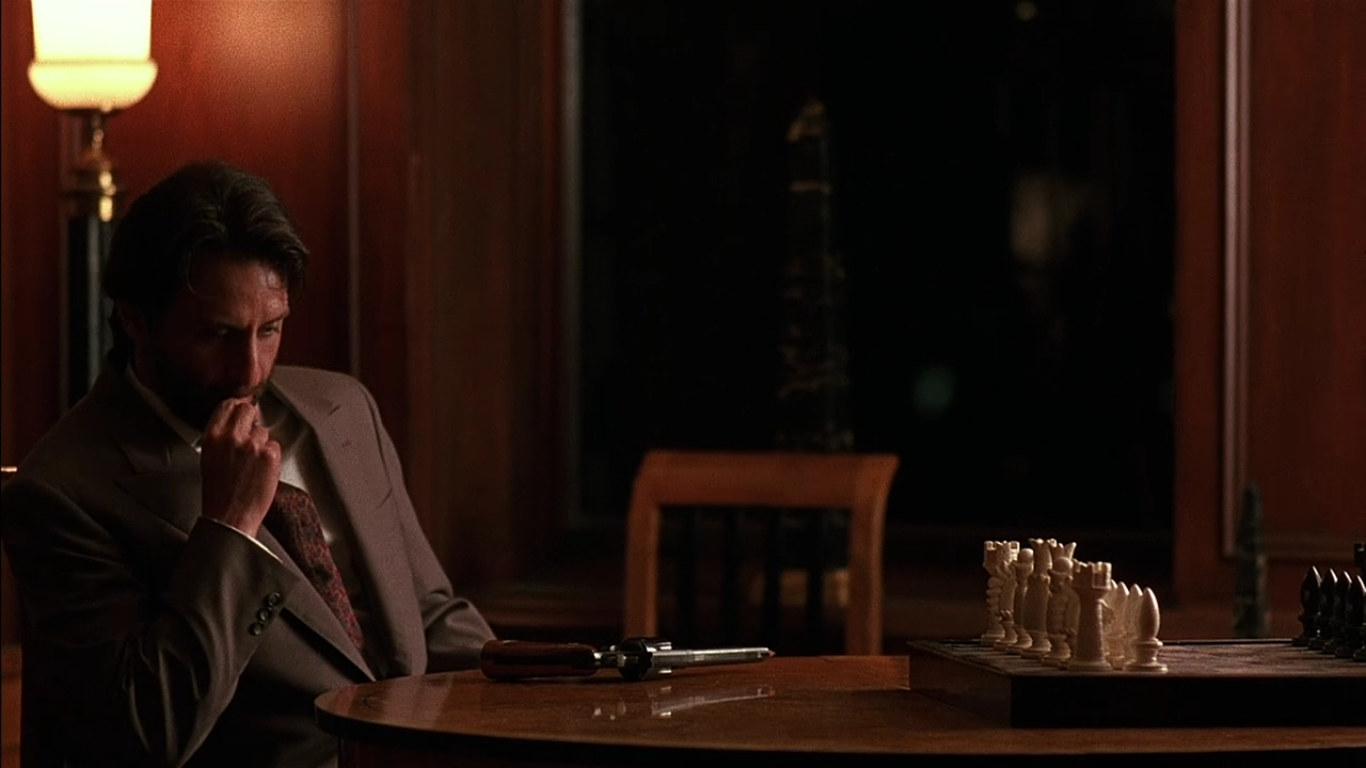 It’s a great horror-movie theme, one that Red will take on as writer-director more completely in Body Parts. Hunt starts wearing the gun down the front of his pants¹ at his job like a bonus dick; when, unholstered, it falls out in front of a random stranger (Hunt has essentially exposed himself to him) Hunt guns him down and leaves a shell casing inscribed with “Megan Turner” at the scene. Immediately after this scene of Hunt losing control of his power and reasserting it, Turner gets put on suspension; since the gun wasn’t at that first crime scene and the cashier wasn’t sure he had a gun in his face (even though it must have been pointed at him for like ten minutes) and somehow no one else saw it, her shooting wasn’t justified, and she has to surrender her badge and gun and power all at once. When she leaves the station, Hunt is there waiting for her; they share a cab and a date.
It’s a great horror-movie theme, one that Red will take on as writer-director more completely in Body Parts. Hunt starts wearing the gun down the front of his pants¹ at his job like a bonus dick; when, unholstered, it falls out in front of a random stranger (Hunt has essentially exposed himself to him) Hunt guns him down and leaves a shell casing inscribed with “Megan Turner” at the scene. Immediately after this scene of Hunt losing control of his power and reasserting it, Turner gets put on suspension; since the gun wasn’t at that first crime scene and the cashier wasn’t sure he had a gun in his face (even though it must have been pointed at him for like ten minutes) and somehow no one else saw it, her shooting wasn’t justified, and she has to surrender her badge and gun and power all at once. When she leaves the station, Hunt is there waiting for her; they share a cab and a date.
Bigelow and Red make a subtle and unusual move here. The more conventional storyline would make Turner the lone main character and would introduce Hunt at this point as a new but uninflected character; that would heighten the mid-film payoff when Hunt gets revealed as the killer leaving “Megan Turner”-inscribed shells. Bigelow, though, has less interest in the standard Deceived Female storyline than the shifts of power defined by the gun and the dick, so she gives Hunt’s and Turner’s storylines equal time and weight and lets us see both of them.
This first half of the film, up to that reveal, plays in a rhythm of denial and reversal: immediately after that first date, the cops find the victim and the shell casing, which leads to Turner being taken off suspension and deputized to homicide detective Nick Mann (Clancy Brown, rocking a full 1980s head of hair and a honking attempt at a New York accent), and she gets her gun and her power back. A later scene where she has to prove her commitment to Mann gets followed by her blowing holes in a target (the classic man’s silhouette), to her satisfaction. Her second date with Hunt ends with a helicopter ride and her invitation into her apartment to enjoy his dick, which he denies (“Soon,” Hunt says) and after he leaves and she goes inside, Mann is waiting there (getting too cutesy with the character names is an Eric Red signature), warning her to stay under his surveillance at all times; “I own you,” he says, reminding that her power has only been allowed by the men who outrank her.
There are little moments of constant casual misogyny all through Blue Steel, most often in the way Turner’s femininity gets read as denying her authority. When she gets hit with the question “you’re a good-looking woman, beautiful, in fact–why would you want to become a cop?” Curtis’ silent reaction says oh not this shit again. (The preceding question is “you wear a gun?”) Bigelow uses the color scheme as much as these moments to isolate Turner and Curtis: out of uniform, Turner often appears in pastels that Bigelow pops against the institutional blues and browns of the men surrounding her, or pushing her to the edge of the frame. Even without Curtis’ performance, she’s a vibrant, vital, desiring person, wanting many things, including a power that everyone wants to deny her.
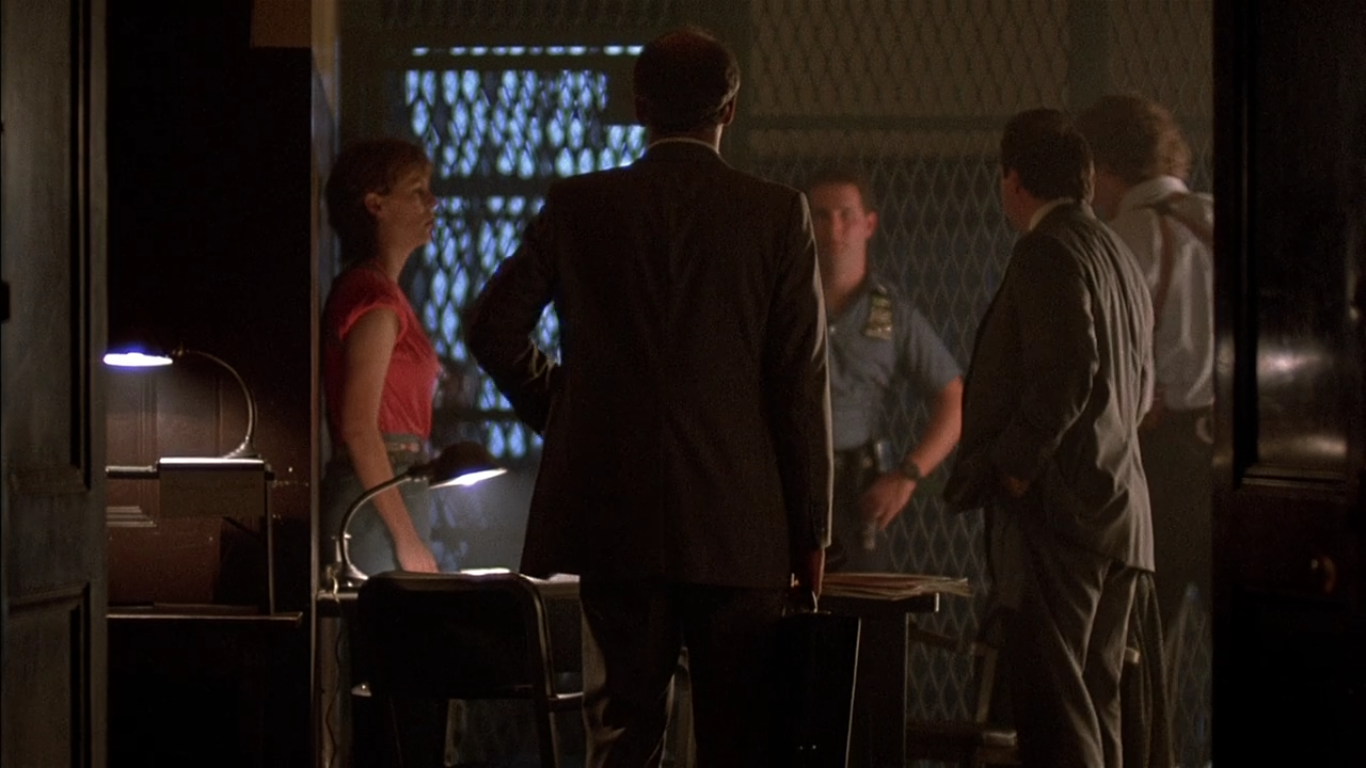 Curtis and Silver make Blue Steel work. (After The Loveless, I’ve never seen an indifferent performance in a Bigelow movie.) Curtis is never not feminine in Blue Steel, in or out of uniform, but she plays an astonishing range of expression, from fear to confidence to resolve to a childlike glee, especially in that graduation scene. (Bigelow focuses on her eyes tearing up; it’s one of the many moments when there’s some of Halloween’s Laurie Strode in Turner.) She can shift those expressions almost as fast as Judy Davis in Husbands and Wives but without any sense of Davis’ neuroses;² Megan Turner knows what she wants, but getting them in this world is a real challenge. Silver goes the other way, reserved and still but charming for all that. Some of that comes down to his smooth and sexy voice; more of it comes from the way he plays Hunt as somewhat awkward and disconnected, the sense that he’ll grant you his secrets in his own time. (This is one reason why it’s a mistake to have Hunt hear voices and give speeches about Turner’s “brightness” and how “death is the greatest kick of all, that’s why they save it for last.” Silver tells us everything we need to know just with his eyes lighting up.) If it wasn’t for his addiction to the power of the gun, Turner and Hunt have pretty good chemistry and some potential as lovers, an emotional charge that’s not necessary for the plot but welcome for the movie as a whole.
Curtis and Silver make Blue Steel work. (After The Loveless, I’ve never seen an indifferent performance in a Bigelow movie.) Curtis is never not feminine in Blue Steel, in or out of uniform, but she plays an astonishing range of expression, from fear to confidence to resolve to a childlike glee, especially in that graduation scene. (Bigelow focuses on her eyes tearing up; it’s one of the many moments when there’s some of Halloween’s Laurie Strode in Turner.) She can shift those expressions almost as fast as Judy Davis in Husbands and Wives but without any sense of Davis’ neuroses;² Megan Turner knows what she wants, but getting them in this world is a real challenge. Silver goes the other way, reserved and still but charming for all that. Some of that comes down to his smooth and sexy voice; more of it comes from the way he plays Hunt as somewhat awkward and disconnected, the sense that he’ll grant you his secrets in his own time. (This is one reason why it’s a mistake to have Hunt hear voices and give speeches about Turner’s “brightness” and how “death is the greatest kick of all, that’s why they save it for last.” Silver tells us everything we need to know just with his eyes lighting up.) If it wasn’t for his addiction to the power of the gun, Turner and Hunt have pretty good chemistry and some potential as lovers, an emotional charge that’s not necessary for the plot but welcome for the movie as a whole.
At the halfway mark, Hunt reveals himself to Turner, and the movie shifts genres, less a gearshift moment than a necessary realization. She decides that “soon” means “now” and starts making out with him and then he bumps into her holstered gun. She apologizes as if it was a premature erection, but he stops and wants her to take it out, take the shooter’s stance: show me your gun and I’ll show you my dick. (This is another scene where it’s all on Curtis and Silver, with her emotions continually shifting and his intent never wavering.) He reveals that he was in the grocery store before and gives himself away as the killer. You can imagine a lot of ways the movie could go from here, but the characters only allow one: Turner asserts her institutional power with the cop’s litany (“You have the right to remain silent. . .”) and arrests Hunt.
From here on out, it’s a straightforward battle between Turner and Hunt, with some assistance from Mann. Bigelow and Red wisely use that there really isn’t any evidence against Hunt, so he’s not going to stay locked up, and that he still has enough cunning to play games against her. They also use Turner’s intelligence and her understanding of Hunt; at one point, she tries to lure him into a justified killing by unholstering her gun, giving him a new dick to grab. (Silver nearly drools in reaction to this.) The back half of Blue Steel allows for some great filmmaking on Bigelow’s part, like a terrifying moment when Hunt comes out of nowhere to kill Elizabeth Peña’s character, and it also heightens the flaws of the movie: that moment depends entirely on Hunt overpowering Turner so completely that she can’t even turn around.
Blue Steel has problems all the way through with plausibility. That’s not something I object to as a general principle (all stories, fictional and non-, depend on some degree of implausibility) but only when it unsuspends my disbelief and takes me out of the story. Too many of the key plot beats rely on things happening because they have to, not because they’re consistent with the characters or the setting. The Hitcher and Near Dark solved these problems in two ways: first, by going by really fast, letting the action take over before we have a chance to worry about things not making sense (Blue Steel is only about 100 minutes but could still lose 15 of them); and second, by taking place in a nearly mythic, unpeopled setting, an anonymous but recognizable American Southwest.
That’s a problem and a conflict here. Bigelow does her best work in mythical or isolated settings, but Blue Steel happens in New York, a place that’s unavoidably real with an unavoidable history. The biggest implausibility here is the one that sets the entire plot in motion: an officer who guns down an armed robber gets suspended, rather than, y’know, made a goddamn hero by the NYPD, the New York Post, and Ed Koch. There’s an indifference to the reality here that will continue all through her career; settings are only a justification for exploring of her characters’ obsessions. Doing that with a place as embedded in our history and politics as New York (or post-Rodney King Los Angeles in Strange Days, or the riots of Detroit) provokes responses ranging from annoyance to are-you-fucking-kidding-me outrage; you need the kind of fidelity to and interest in detail of Michael Mann or non-Bourne Paul Greengrass to bring this off. Her indifference extends from the plot to the visuals: Bigelow repeats a motif characters looking forward shot in shallow depth-of-field to create images of faces with backgrounds reduced to blurred points of light.³ It’s striking, beautiful, intimate, painterly, and it makes me wonder how much of this film was shot on a soundstage.
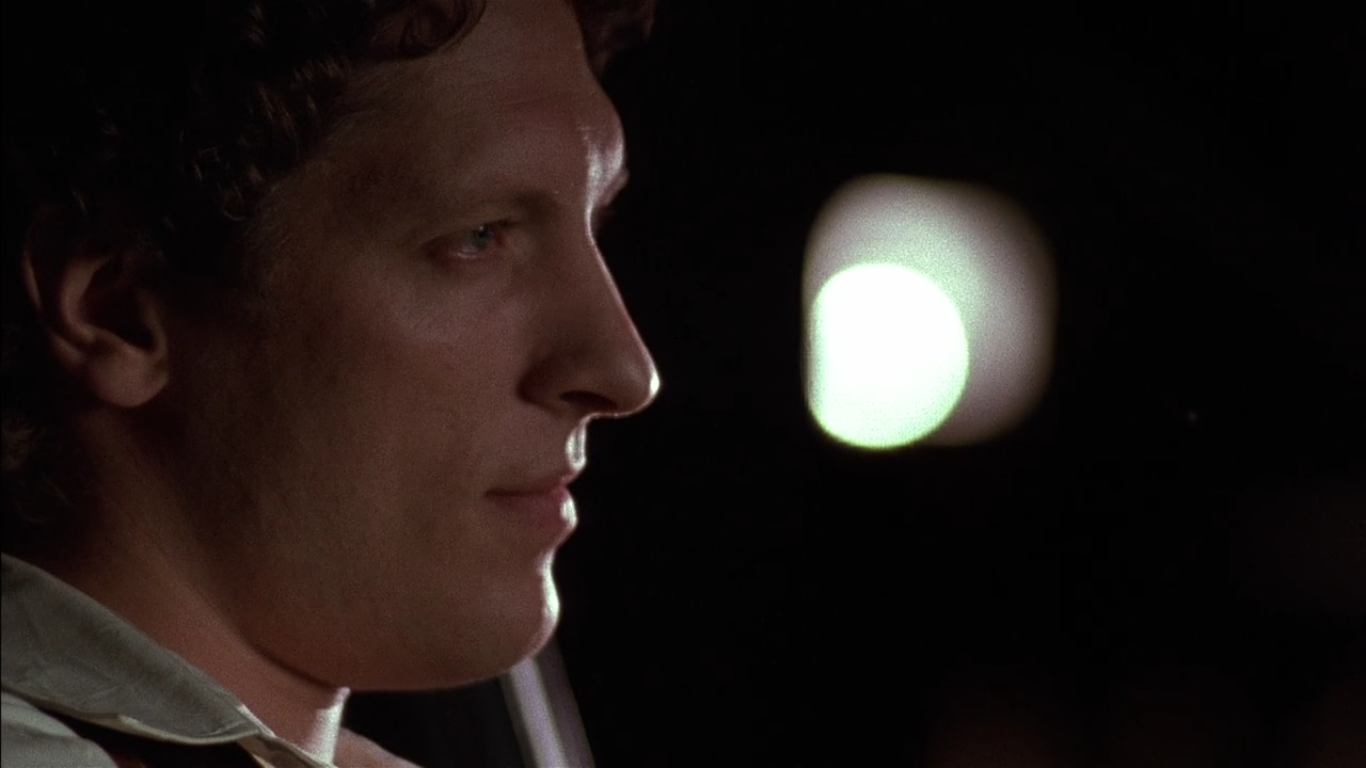 Bigelow makes another choice here that starts off brilliant and veers into error. After her graduation, we get a brief moment with Turner and her parents (Louise Fletcher and Philip Bosco) with her asking why they didn’t show up, with all three of them shifting between levels of openness in fear and hostility. Knowing the world Turner grew up in throws forward to the moment in the second half of the film when Mann asks the same question just about every other man asks Turner: “why did you become a cop?” She’s been Joker-like evasive with her answers up to now, but here she just says “him.” On the surface, she means Hunt; but the real meaning is every man in her life who’s tried to dominate and deny her, going back to her father. That’s great and effective and has the directness that Bigelow does so well so often. What doesn’t work is the scene where Turner sees her mother bruised and flat-out arrests her father, then lets him go and that’s all we get. If Bigelow and Red want to make the abuse a story, then it needs to be a story, not a two-beat subplot that leaves things exactly as they were before; it strips the first moment of its thematic power.
Bigelow makes another choice here that starts off brilliant and veers into error. After her graduation, we get a brief moment with Turner and her parents (Louise Fletcher and Philip Bosco) with her asking why they didn’t show up, with all three of them shifting between levels of openness in fear and hostility. Knowing the world Turner grew up in throws forward to the moment in the second half of the film when Mann asks the same question just about every other man asks Turner: “why did you become a cop?” She’s been Joker-like evasive with her answers up to now, but here she just says “him.” On the surface, she means Hunt; but the real meaning is every man in her life who’s tried to dominate and deny her, going back to her father. That’s great and effective and has the directness that Bigelow does so well so often. What doesn’t work is the scene where Turner sees her mother bruised and flat-out arrests her father, then lets him go and that’s all we get. If Bigelow and Red want to make the abuse a story, then it needs to be a story, not a two-beat subplot that leaves things exactly as they were before; it strips the first moment of its thematic power.
It’s also a structural problem, because the second half of Blue Steel just keeps driving forward, shedding not just plausibility but also characters, coming down to the Turner/Hunt conflict and nothing else. After a great action scene in Central Park (or a reasonable facsimile thereof), Turner and Mann retreat to her apartment and have drinks and then sex, which comes off as the least improbable thing of the day’s events, because, surprise! even though Turner is supposed to be under surveillance, Hunt somehow got there unnoticed and is now silently tending to his bullet wounds in the bathroom. Bigelow shoots the sex in the gauzy, blue-filtered style of Top Gun, but there’s a unique touch in her attention to sounds, which is both sensual and heightens the fear: it’s what Hunt would hear. Afterwards, Turner has that cigarette she promised herself after graduation and, using a silencer improvised from a towel Godfather 2-style, Hunt shoots Mann in the bathroom.
Then he rapes Turner. It’s another moment when he overpowers Turner because the plot requires him to; it’s also brutal, effective filmmaking, Silver going into an animal register we haven’t seen yet, Curtis holding off panic and still able to fight. There’s something unique here, something Bigelow gets that other filmmakers don’t: she makes this entirely about power, never about desire. We see a life-and-death struggle, nothing more or less: Hunt fights with his dick while Turner tries to get to the gun. On my first viewing, I didn’t see this as necessary, but now I’ll trust her judgment.
What’s so dislocating about Blue Steel is that Bigelow crafts the theme of gun/dick/power without gender, a force that’s beyond male and female. Possessing the gun, or the dick for that matter, doesn’t grant masculinity, and their absence doesn’t define femininity. Turner and Hunt struggle for ownership and control of gun/dick/power through the movie, but that never moves either of them away from being a woman and a man. Bigelow’s fevered, almost hallucinatory style may be the only way to approach this kind of story; the only other thing I can compare it to is David Mamet’s Oleanna, my pick for his best play on the page and completely impossible on the stage, an abstract portrayal of power that fails whenever it has to be embodied by a real woman and a real man. Bigelow’s legacy from the horror genre continues into Blue Steel, especially in its second half, in horror’s ability to make the impossible something that’s really happening in front of our eyes.
That legacy comes to fullness in the final scene. Mann lives, Turner refuses sedation at a hospital and knocks out another cop and suits up in his uniform and gun. (Great touch that it doesn’t fit, making this moment a corrupted echo of the credit sequence.) Like any horror film, we’ve come down to the Final Girl and the Monster and shed any care for plausibility; Turner and Hunt are now at the point where they can sense each other’s presence without looking, and open fire without caring if there are crowds of civilians around. The ending follows that of The Hitcher, as Turner can only kill Hunt after he runs out of bullets and becomes completely defenseless. Bigelow uses that shallow depth-of-field to almost obliterate Turner and make the gun, almost autonomous, open fire on Hunt and kill him. Then she rack-focuses back to Turner, letting her come back into our presence. She drops the gun and, in a shot that’s another echo/reversal of the credits, it lands in Bigelovian slow motion, empty, spent, as limp as piece of blue steel can be, and she’s led off and the movie ends. This is the Near Dark ending, because there’s no sense of justice, victory, or even resolution; what, structurally, should be a happy ending comes off as a loss. Megan Turner no longer has the gun, and what is left of her?
¹Never do this.
²She married some dork around this time who also makes movies, and years after she dumped his ass, said dork made a movie with Curtis. You’re welcome to dig up who it was and compare what they did with her; there’s one scene in particular that feels like a denial of all the strength of Blue Steel.
³In its creation of a mythical New York hellscape and the violent characters moving through it, this is Bigelow’s version of Taxi Driver, and my reading of it was inspired by two critical comments on the earlier film, one from Pauline Kael (“The fact that we experience Travis’s need for an explosion viscerally, and that the explosion itself has the quality of consummation, makes Taxi Driver one of the few truly modern horror films”) and one from Amy Taubin (her description of Travis Bickle buying guns as “it’s as if Travis was being offered a set of cocks, in all shapes and sizes. He takes them all.”) It’s so Bigelow that she takes some of the same obsessions as Scorsese/Schrader, loses any sense of realism, and heightens them even farther into artistic delirium.
Previously: Near Dark (1987)
Next: Point Break (1991)

